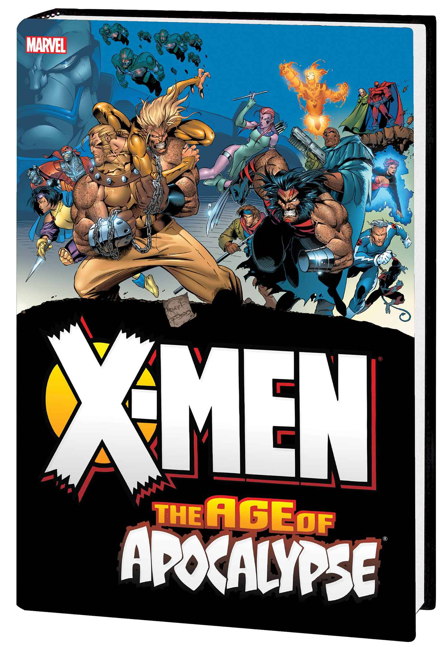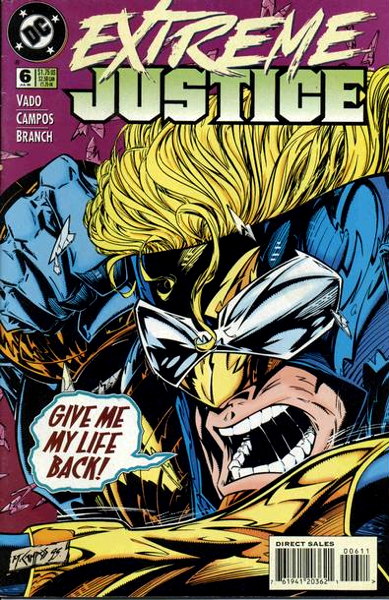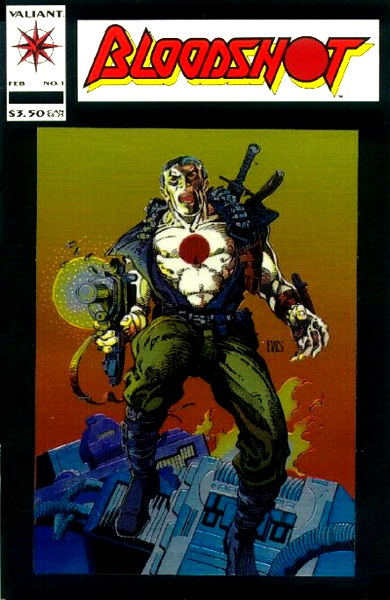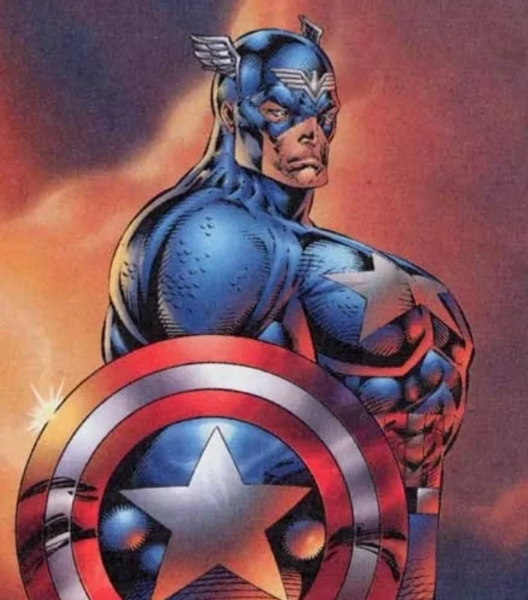Like they all aren’t facetious.
Back to the Most 1990s Comic discussion…as a reminder, my personal pick for the title is X-Force #1 for both artistic and marketing reasons. But, you folks have brought up some good contenders, so let us continue with Tom W and Marvel’s The Age of Apocalypse event (1995):

In my very long-ago pre-internet days, I did a little write-up on the announcement of this event for one of the BBSes I frequented. I can’t recall exactly what I said, all these years later, but I vaguely recall saying something along the lines that this was a drastic attention-getting stunt to grab the readers they could during what was a very apparent industry downturn from the salad days of just a couple years prior. Or if I didn’t say that, I should have.
This was one of those “alternative timeline” stories, where via some time-traveling shenanigans the Marvel Universe finds itself drastically changed, and all the regular X-titles were replaced for a few months by mini-series set in this milieu. For example, Wolverine became Weapon X, Generation X became Generation Next, and I’m not sure what was turned into Gambit and the X-ternals but that series was there too.
Tom describes the comics as containing “characters that are naught but grimaces and cool, endless splash pages of distorted, indecipherable anatomy [and] barely-there plotting” which may be the case, but it certainly sold well at the time and sold out of the back issue bins for quite a while thereafter. They don’t move quite as much now, but the chromium-covered X-Men: Alpha and, to a lesser extent, X-Men: Omega, which bookended the event, still sell fairly well.
As an embodiment of 1990s Comic Sins, I’m not sure how to categorize this. It is, as Tom noted, an attempt to latch onto then-current trends of comic book storytelling popularized by Image and its other imitators. My initial sarcastic idea was to put it in the “Hello, Fellow Kids” category, but to be honest, Marvel’s own form of 1990s excess was at this point well into its own unique style. And, y’know, it wasn’t all completely terrible, to be fair (here’s Chris B for the defense). So maybe let’s file this under “Forget Everything You Know” for its parallel universe stuff. But I’m open to suggestions.
Roel notes a few contenders, but let’s go with the one he specifically emphasized, and that’s the slightly infamous Extreme Justice (DC, 1995-6)…also noted by Rob S farther down in the comments:

As Roel says, “it looks like DC Comics badly cosplaying Image Comics,” which makes me want to place it in the aforementioned “Hello, Fellow Kids” category. More so than pretty much any other Marvel or DC book I’ve seen, Extreme Justice tried to emulate the, as it says on the tin, “extreme” art style that all of Today’s 1990s Youth were into, and cargo cult-style hoping that would draw in the big numbers that Image was, or at least had been, receiving. It only lasted a year and a half, so clearly it didn’t.
I’d only read a couple of issues of this series myself, and that was more than plenty. The most egregious of this title’s transgressions was its reworking of Booster Gold, who’d been generally a genial and occasionally goofy character, into whatever that is pictured on the cover I posted above. He was refitted with an armored costume, which I remember had one reviewer asking “if you’re going to be armored, why would you leave the top of your head exposed” which seemed like a good question to me.
This was a real try-hard of a book, and I’m not going to blame the creative team as they were likely following an editorial edict to “MAKE THIS COMIC KEWL.” In fact, the previously used “Kewl Style” category is probably where this should land, even if that doesn’t seem strong enough. The near-manic desperation of it probably overlaps with my somewhat facetious “Hello, Fellow Kids” category, so let’s give it that one too I mean, why not.
Joseph brings up Valiant’s Bloodshot #1 (Valiant 1993):

…which he compares to the slightly-fancier-covered (and already discussed) Turok Dinosaur Hunter #1 from the same company. This would probably just go into the general 1990s Sins “Gimmick” category, with its chromium card glued to the cover there. But as 1990s comics go, this isn’t…quite the offender as other titles have been, or at least it isn’t seen in quite the same like as that Turok first issue.
According to the Valiant Fans site, it had a print run of about 850,000 copies, which some publishers would push their favorite auntie into an industrial shredder to get those kind of numbers now. But that’s only about less than half of Turok #1, which feels slightly more ubiquitous. Not that Bloodshot #1s aren’t hard to come by (I think I have three in my store right now), but if I recall correctly sold quite well at the time and continued to sell as back issues afterward.
So I’ll probably stick with the “Gimmick” category for this one. As 1990s comics go, this wasn’t quite the burden on the marketplace as others have been.
JohnJ brings up the dreaded “Chesty Cap” image drawn by Rob Liefeld:

JohnJ mentions not being able to find the cover this is from, but it’s actually from an ad if I recall correctly, that ran on some back covers here and there. An ad for what, exactly, I don’t know…a convention or a mail order house or some damned thing, I don’t particularly feel like delving too deep in Liefeldity right now. (But this cover is pretty close.) Also, apparently there’s a new explanation for why the drawing…looks like that going ’round, decades after the fact, but again don’t really want to entertain RL too much.
The actual Captain America comics Liefeld briefly worked on didn’t feature anything quite as extreme as the above image. Not saying they were good, but they at least weren’t as epically…let’s say “fanciful” as that pic.
Now in its own way this is about as iconic a representation of what 1990s comics were all about as any actual comic you can think of. It’s not a specific comic, though, so I should likely exclude it from categorization. I’m not even sure what category I’d put on it if I did. “The Rob Liefeldest,” perhaps?
So that’s it for that this time around. I’ll address more of your suggestions soon…but in the meantime don’t forget to give me your 2024 comic industry predictions!








That Liefeld Cap image is from the opening dream sequence in the first Heroes Reborn issue of Captain America.
The dream of Steve Rogers about getting breast enhancements, apparently.
Look at his face. He’s just daring you to judge him. Good for Cap, having that level of self-esteem.
Gambit and the X-Ternals was the renamed X-Force series. The fact that X-Force wasn’t renamed something like Blood Force for AOA shows that Age of Apocalypse was more a sign that the ‘90s were coming to an end for the comic book industry.
I guess trying to sell a comic using the name value of Gambit is something that you would only see in the 1990s.
Booster Gold is one of the few DC characters that I wouldn’t mind Tom King killing off.
Beyond Captain America’s malformed chest and torso, why was Liefeld given permission to mess up Simon and Kirby’s iconic costume design by adding a wing symbol on Cap’s forehead and doing away with the “A”? Sacrilege!
Tip o’ my hat to you, Mike, for choosing Booster Gold as the poster child for the _EXTREME_ era Justice League. In my humble opinion, Booster’s storylines in the book (as a dead man trapped in life-supporting armor — nothing at all like some character at another publisher) were the best.
Your other options included giving Firestorm cancer and alcoholism, Captain Atom fighting the Captain Atom of another universe who actually did become Monarch, and the introduction of the post-CRISIS Wonder Twins as alien royalty hunted by intergalactic slavers.
I might be the only person on the planet who loves that series, but I’d also be the first to admit that it is, shall we say, an acquired taste.
Didn’t Bloodshot #1 also release the same day as Superman #75?
Please no links to Millar’s videos.
Anthony S – Just looked through that issue (and…oof, the things I have to do for this site) and while there are similar images, that exact pic of Cap does not appear.
I should clarify here that I like Age of Apocalypse otherwise I wouldn’t have dropped so much money on the omnibus. While excessively 90s it channels that sturm-und-drang of the Claremont X-Men beautifully. It’s essentially Days of Future Past in its final form, bloated up by the size of the whole X-line, and it still has those same joys: who’s this character become? What about this one? Chris B was right, there is a lot more going on in the central X-comic than just Magneto moping, a lot of characters and titles are sent off on pointless quests but that’s true of any crossover. The saga of the Summers brothers is well-conceived and epic in conclusion.
On its own it probably isn’t the most 90s comic, as compared to the other contenders, but it’s a capsule version – someone unfamiliar with the Chromium Age, as I wasn’t because I was too busy being into Vertigo, could read it and understand what that end of the 90s was about.
(And of artists who sold out their talent for that keel 90s style, the worst offender has to be Shaun McManus for the Nick Fury/Wolverine Scorpio Rising GN. It hurts watching an artist who can draw so well drawing so deliberately badly.)
All this 90s talk begs another question, for another series here on Prog Ruin: I know what the mainstream comics style of the 60s was, Marvel’s dynamism and DC’s new crop of heroes. And of the 70s, which was wilder, more trend-chasing and chaotic, more inclined to the weird. But what about the 80s? What was the dominant style of mainstream comics?
I’d have to say it was a slightly studied seriousness and consolidation, that Claremont X-Men or New Teen Titans mode of recognising and respecting continuity and the long-haul reader. New origins and putting everything in its place, from Miller’s Daredevil finding out who trained him and how his powers worked to the great sweeping-up of Crisis On Infinite Earths. Before all that got overthrown for the craziness and proliferation of the 90s.
@ Tom W
I would say that the dominant style of mainstream comics in the ’80s –at least the first half of the ’80s, pre-COIE–was hope. Hope for the end of the Cold War, hope for a better tomorrow, hope for the environment, hope for equality. And family. Another dominant theme of most of the top selling mainstream books–X-Men, New Teen Titans, Legion of Super-Heroes, New Mutants, Micronauts, etc., was teams which functioned as extended families…which were trying to build a better tomorrow. And as Gen. X latchkey kid, I loved it.
I think by contrast a lot of the mainstream ’70s comics were about discontent and dystopia and future shock– mirroring the discontent and anger over the Vietnam War, Nixon and Watergate and the aftermath. Green Lantern/Green Arrow, War of the Worlds/Killraven, Deathlok, Howard the Duck, Man-Thing, Warlock…all of those series were so 1970s. Star Wars helped turn the corner on that by the late ’70s and made it cool again for there to be an extended family of heroes fighting for a better tomorrow.
I would also say that the ’80s was when the Baby Boomer generation of fans turned pros finally came into their own and ascended to the top of heap: Jim Shooter, Paul Levitz, Marv Wolfman, Len Wein, Chris Claremont, Alan Moore, etc. This was a progressive generation who generally believed in being good stewards of the characters, keeping continuity as intact as possible and building legacies. Also, the artists of the late ’70s into the ’80s were top-notch and in many cases visionary creators…George Perez, John Byrne, Frank Miller, Walt Simonson, Jim Starlin, Jose Luis Garcia-Lopez, Dave Cockrum, P. Craig Russell, and so many more. It was the zenith of the mainstream American comics medium.
Geez — I never knew what the storylines of Extreme Justice were. They sound absolutely dire. At least I know how Firestorm got ruined now.
Someone posted an image to the internet of Liefeld’s Chesty Cap without any clothes on. I won’t link to it here, obviously, but it’s funny. Apparently, you can also see what his skeleton would look like, which is also funny.
I was a kid picking up random issues of superhero comics from magazine racks and Age of Apocalypse came out the month I started going to the local comic book shop. I don’t really recall why I was so taken by them (being able to start from #1?) but I bought all of the #1s, got a bunch of the other issues as they were coming out, and eventually bought the back issues to complete the whole event. I can understand why people don’t like it, but it’s an important part of my comic-reading history and I still think it’s better than most other superhero crossovers.
“Chesty Cap”
That’s STILL one of the worst pieces of art I’ve ever seen!
Also, Gambit SUUUUUUUUUUUCKS!
@ Sean
Agree on the 70s being as discontented and directionless as society was, but I’m not sure on the 80s being Hope. The defining mainstream 80s comic was probably X-Men and there was little hope within it, their status quo of battling to save people who hated and feared them never changed.
I think your second point’s uncontestable, though: this is the era where fans grew up, got jobs in the industry and the industry began to take itself somewhat seriously. There’s a recognition that these stories aren’t being thrown into the wind, that people save and collect them and care about the characters and remember random issues that screw with the continuity. That’s what I meant about consolidating; Teen Titans, say, built itself a little world and explained origins, smoothed inconsistencies took itself seriously even when about the same business as the Silver Age.
The Editor’s Note era, maybe? For ‘SEE FF #237 FOR THE LAST APPEARANCE OF SHOE-MAN’.
@Tom W.
I would say that for me the mid-’70s to mid-’80s Bronze Age comics are the sweet spot. I think it’s great that we got Steve Gerber, Steve Englehart, Don McGregor, Jim Starlin, Frank Brunner and others to comment on contemporary events of the cultural climate of the ’70s and its discontents, and also address counterculture values, through their
comics.
Even the Claremont/Cockrum X-Men run, to me, is an outgrowth of the ‘7Os counterculture in that you have an international cast of mostly young people living communally with shared values as
an extended family. I think that’s what I meant by hope …not saying the X-Men didn’t have to combat bigotry, prejudice, intolerance, Sentinels, Hell Fire Clubs, etc. Also, concurrent to the X-Men, and also somewhat due to Dave Cockrum’s art and great costume revamps, the Legion of Super-Heroes was also picking up steam at DC as the late ’70s entered the early ’80s
–and that comic was generally about hope for a more utopian future, even if the Great Darkness Saga and other events happened. I think it also became about the publishers marketing young teams to Gen X preteen and teenage readers…even the JLA couldn’t escape the trend, and we got Justice League Detroit.
Maybe instead of “hope” I should have written “humanism”? I just recall a lot of good comics being written and drawn during that period that explored the human condition, with all of its aspirations and foibles. I recall generally well-rounded characters and compelling plots and good value for money.
New Teen Titans, when I reread it now, had a lot of good points, but I think the George Perez art is the main thing that made it special. I always preferred the original iteration of the Teen Titans. I like Lilith Clay way more than Raven. Cyborg seemed like a mixture of Mal Duncan with Deathlok–I would have just as soon had Mal back on the team as The Guardian, and I really disliked that retconned Vox superhero identity they gave him. But on the other hand, Starfire was cool (but it is lame that DC hasn’t just retained her look and costume which George Perez created), and Changeling/Beast Boy was a nice addition to the team. It was great that Wolfman followed up on what happened to the original Doom Patrol, as they had been killed off about a decade prior…except for Cliff. “Who Is Donna Troy?” was great, but post-COIE that got all messed up. I just wish she could reclaim the mantle of Wonder Girl and he classic red jumpsuit look. Also, Donna and Roy Harper should have ended up as a couple and got married. I never cared for Wolfman’s characterization of Wally
West…he made him bland. I also wasn’t a big fan of Jericho and Cole, and by the time Pantha and Baby Wildebeest were part of the story, forget it. But the Perez art of those first fifty or so issues and the first several Baxter series issues was superlative.
*her classic red jumpsuit…sorry, it wasn’t my intent to use the wrong pronoun when referring to Donna Troy.
Look, Cap went through a rough patch and blew off steam by shoplifting pillows.